warning light AUDI A4 2016 Owner's Guide
[x] Cancel search | Manufacturer: AUDI, Model Year: 2016, Model line: A4, Model: AUDI A4 2016Pages: 278, PDF Size: 70.26 MB
Page 66 of 278
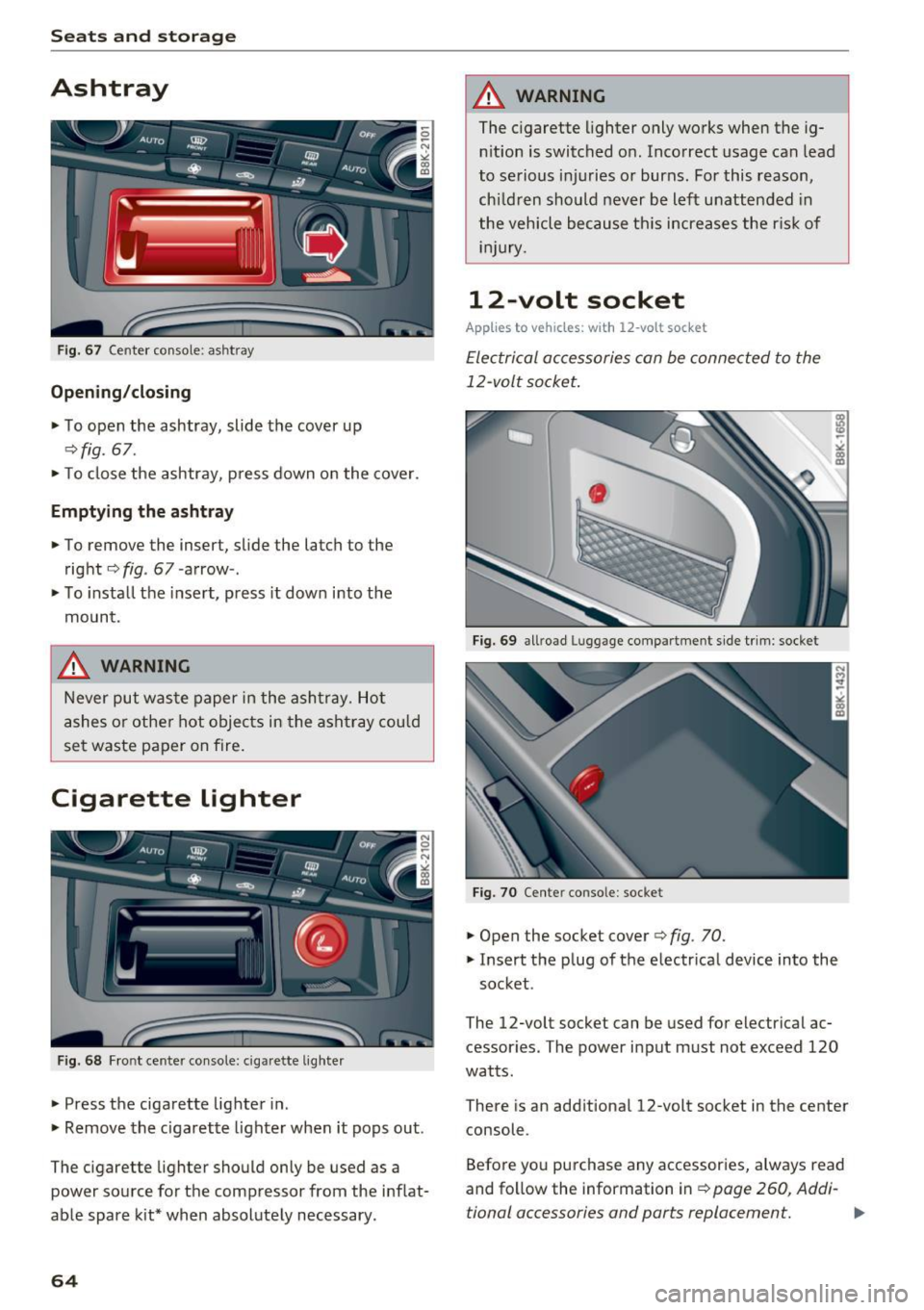
Seats and storage
Ashtray
Fig. 67 Center console: as htray
Opening/closing
.,. To open the ashtray, slide the cover up
q fig . 67 .
.,. To close the ashtray, p ress down o n the cover .
Emptying the ashtray
.,. To remove the insert, slide the latch to the
right
<=> fig . 67 -arrow -.
.,. To install the insert, press it dow n into the
mount.
,&. WARNING
-
Never put waste paper in the ashtray. Hot
ashes or other hot objects in the ashtray could
set waste paper on fire.
Cigarette lighter
Fig. 68 Front cente r console: c igarette l ighte r
.,. Press the cigarette lighter in.
.,. Remove the cigarette lighter when it pops out .
The cigarette lighter should only be used as a
power source for the compressor from the inflat
able spare kit* when absolutely necessary .
64
,&. WARNING
The cigarette lighter only works when the ig
nition is switched on. Incorrect usage can lead
to serious injuries or burns. For this reason,
ch ildre n should never be left unattended in
the vehicle because this increases the ris k of
in jur y.
12-volt socket
Appl ies to vehicles: with 12-volt socket
Electrical accessories can be connected to the
12-volt socket.
Fig. 69 allroad Lu ggage compartment side trim: socket
Fig. 70 Cente r conso le : socket
.,. Open the socket cover¢ fig. 70 .
.,. Insert the plug of the electrical device into the
socket .
The 12-volt socket can be used for electrical ac
cessor ies. The power input must not exceed 120
watts .
There is an additiona l 12-volt socket in the center
console.
Before you purchase any accessories, always read
and follow the information in¢
page 260, Addi-
tional accessories and ports replacement. .,,_
Page 67 of 278
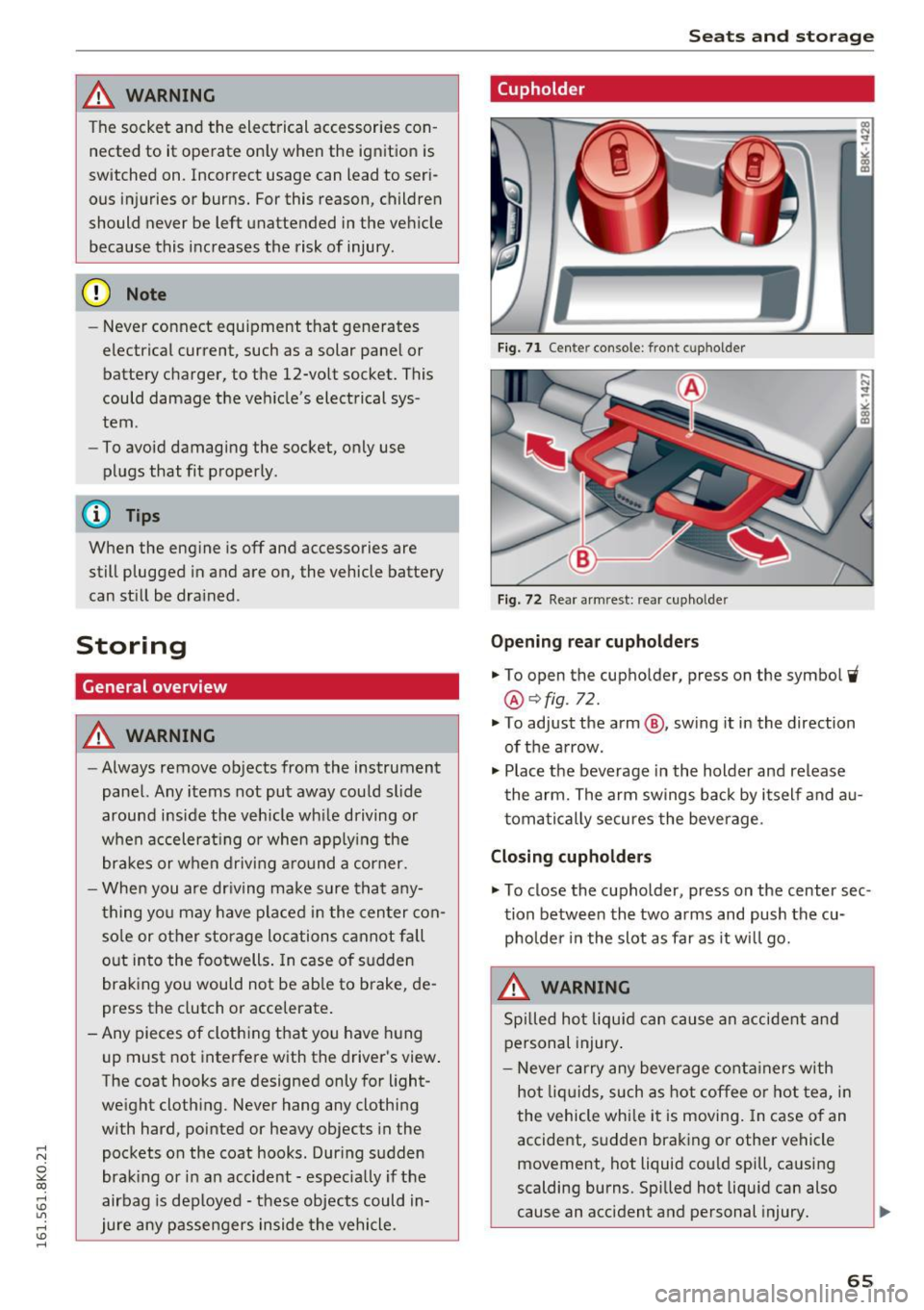
,....,
N
0
""' CX) ,....,
I.Cl U"I ,....,
I.Cl ,....,
/! WARNING
The socket and the electrical accessories con
nected to it operate on ly when the ignition is
switched on. Incorrect usage can lead to seri
ous injuries or burns. For this reason, children
should never be left unattended in the veh icle
because this increases the risk of injury.
0 Note
- Never connect equ ipment that gene rates
electrical current, such as a solar pane l or
battery charger, to the 12-volt socket. This
could damage the ve hicle's electrical sys
tem .
- To avoid damag ing the socket, only use
plugs that fit properly .
@ Tips
When the engine is off and accessories are
still plugged in and are on, the vehicle battery
can sti ll be dra ined .
Storing
General overview
A WARNING
-Always remove objects from the instrument
panel. Any items not pu t away cou ld slide
around inside the vehicle wh ile driving or
when accelera ting or when app ly ing the
bra kes or w hen driv ing around a corner.
- When you are dr iv ing make sure that a ny
t hing yo u may have pla ced i n the cen ter con
so le or other sto rage locations cannot fall
o ut into the footwells . In case of s udden
brak ing you would not be ab le to brake, de
press the clutch or accelerate .
-Any pieces of clothing that yo u have hung
up must not interfere with the driver's view .
The coat hooks are designed only for light
weight cloth ing . Never hang any clothing
with hard , pointed or heavy objects in the
pockets on the coat hooks . Dur ing sudden
brak ing or in an accident -especially if t he
airbag is deployed -these objects could in
jure any passengers inside the vehicle.
Seats and storag e
(upholder
Fig. 71 Cen te r conso le : fr ont cuph older
Fig. 72 Rea r a rmrest: rear cupho lder
Opening rea r cupholders
.. To open the cupho lder, press on the symbol ii
® qfig . 72 .
.. To adjust the arm @, sw ing it in the direction
of t he a rrow .
.. Place t he beverage in the holder and release
the arm. The arm swings bac k by i tself and a u
t oma tically secures the beve rage.
Closing cupholders
.. To close the cupholder, press on the center sec
tion between the two arms and push the cu
pho lder in the slot as far as it wi ll go.
A WARNING
Spi lled ho t liqu id can cause an accident an d
personal injury .
- Never carry any beverage c ontai ners w ith
hot liq uids, such as hot coffee or hot tea, in
t he vehicle whi le i t is movi ng. In case of an
accide nt, sudden brak ing o r other ve hicle
movement, hot liquid co uld spill , ca using
scalding burns. Spilled hot liqu id can also
cause an accident and personal injury.
65
Page 68 of 278
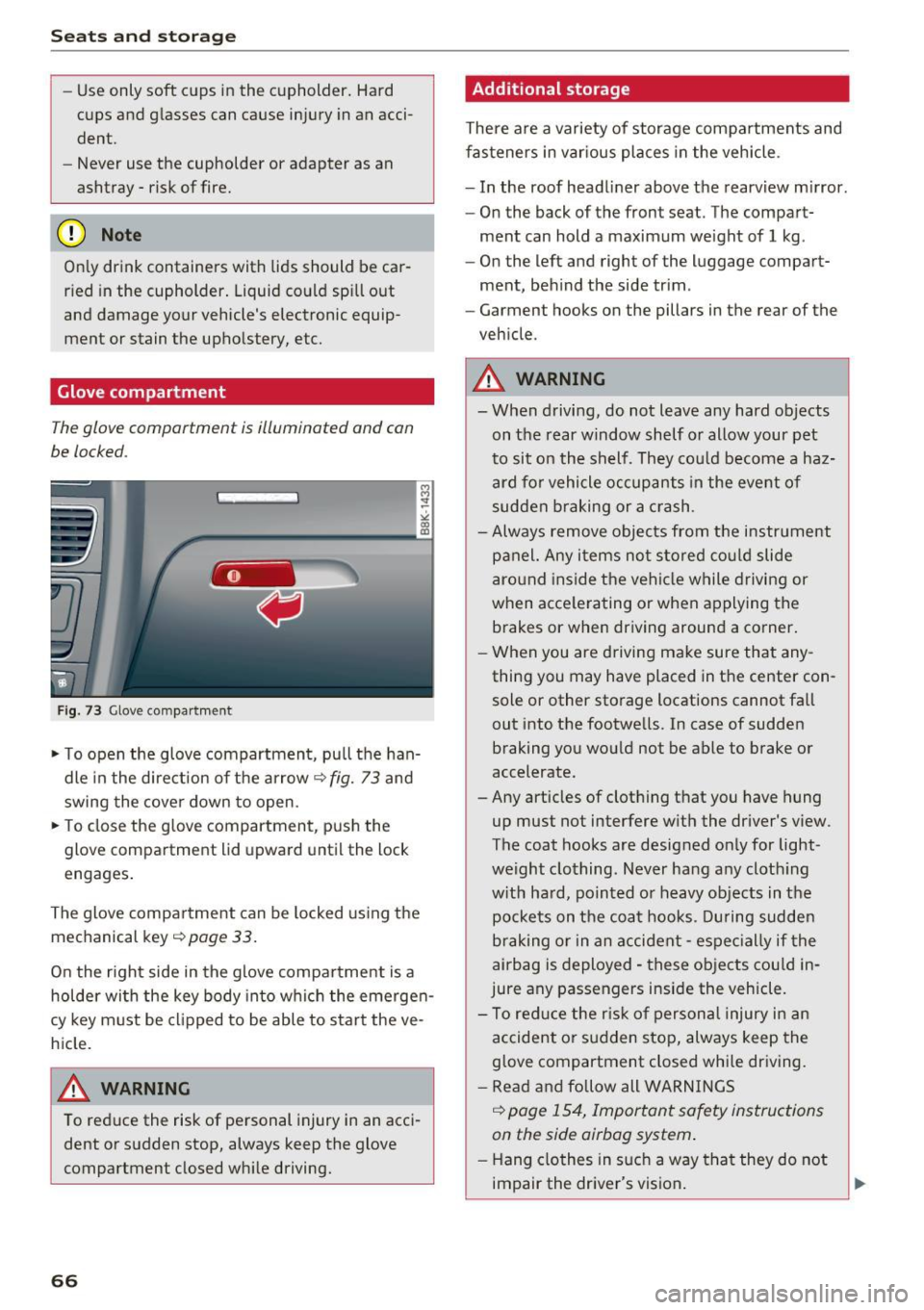
Sea ts and stor age
- Use only soft cups in the cupholder. Hard
cups and g lasses can cause injury in an acci
dent.
- Never use the cupholder or adapter as an
ashtray -risk of fire.
(D Note
On ly drink containe rs with lids should be car"
r ied in the cupholder . Liquid co uld spill out
and damage your vehicle's electronic equip
ment or stain the upho lstery, etc.
Glove compartment
The glove compartment is illuminated and can
be lo cked .
Fig. 73 Glove compar tment
M M ., ~ ' ,.:
"' IX)
• To open the glove compartment, pull the han
dle in the direct ion of the arrow¢
fig. 73 and
swing the cove r down to open .
• To close the g love compartment , pus h the
glove compartment lid upwa rd unt il the lock
engages .
The glove compartment can be locked using the
mechan ical key ¢
page 33.
On the right side in the glove compa rtment is a
holder with the key body into which the emerge n
cy key m ust be cl ipped to be able to start the ve
hicle.
A WARNING
To red uce the risk of personal injury in an acc i
dent or sudden stop, always keep the glove
compartment closed wh ile driving.
66
Additional storage
There a re a variety of storage compartments and
fasteners in var ious places in the veh icle .
- In the roof head liner above t he rearview m irror .
- On the back of the fron t seat . The compart-
ment can hold a maximum we ight of 1 kg .
- On the left and right of the luggage compart
ment, beh ind the side trim .
- Garment hooks on the pillars in the rear of the
vehicle .
.,&. WARNING
- When driving, do not leave any hard objects
on the rear window shelf o r allow your pet
to sit on the shelf . They co uld become a haz
ard for vehicle occupants in the event of
sudden b raking or a crash .
- Always remove objects from the instr ument
panel. Any items no t stored co uld slide
aro und inside t he vehi cle while drivi ng or
when acce le rating or when a pplying the
brakes or when dr iving around a corner.
- When you are driving make sure that any
thing you may have placed in the center con
sole or other storage locations cannot fa ll
out into the footwells. In case of sudden
braking you wo uld not be able to brake or
accelerate.
- Any articles of clothing that you have hung up must not interfere with the driver 's view .
The coat hooks are designed on ly for light
we ight clothing . Never ha ng a ny clot hing
w it h ha rd, pointed o r heavy ob jects in the
pockets on t he coa t hooks. Du ring sudden
braking or in an acciden t -espe cially if the
ai rbag is deployed -these ob jects cou ld in
jure any passengers inside the veh icle .
- To reduce the r is k of person al injury i n an
accident or sudden stop, always keep the
glove compartment closed while dr iving.
- Re ad a nd follow alt WARN INGS
¢ page 154, Important safety instructions
on the side airbag system .
-Hang clothes in such a way tha t they do not
impair the drive r's vision . ,...
Page 69 of 278
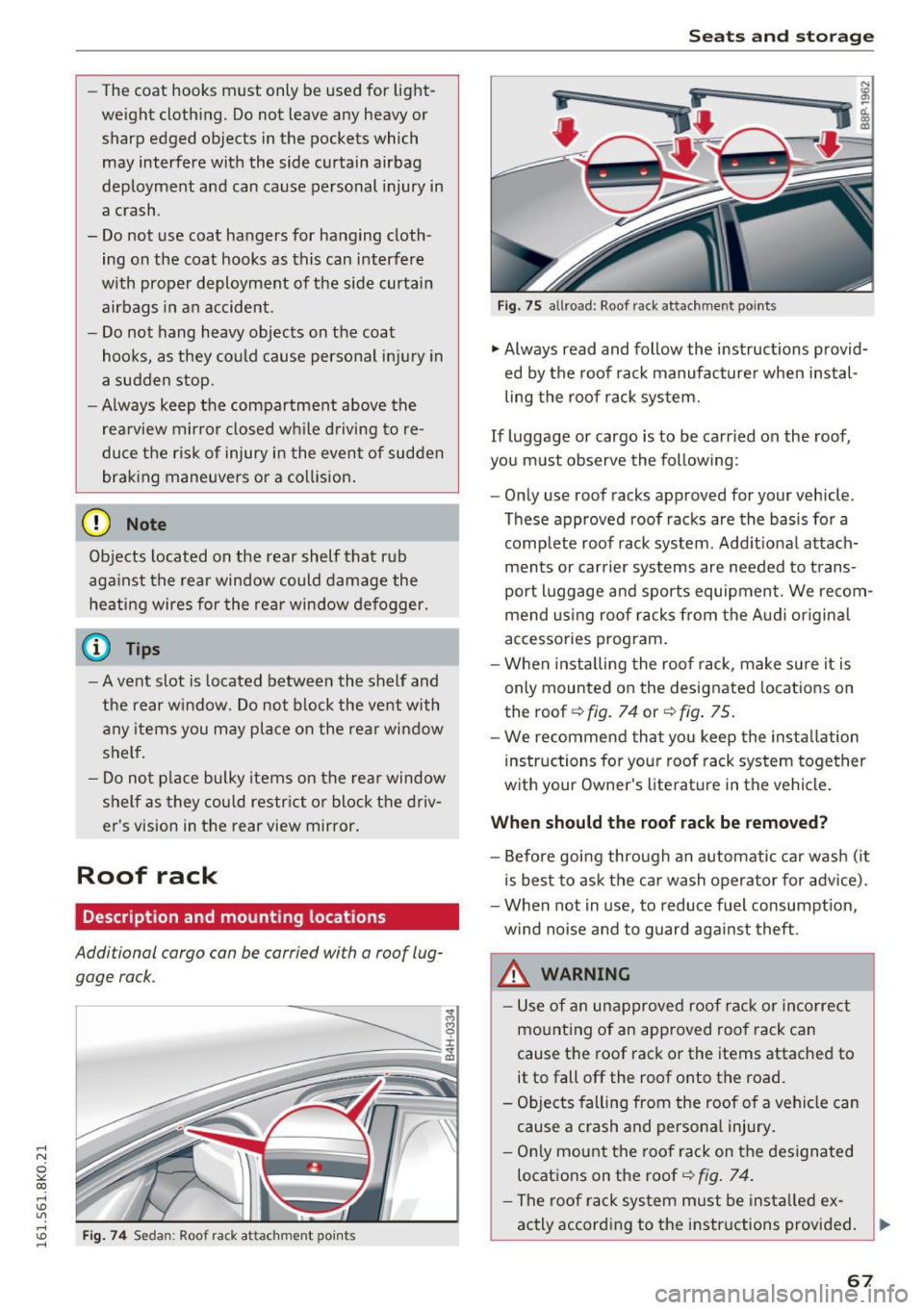
,....,
N
0
""' CX) ,....,
I.Cl U"I ,....,
I.Cl ,....,
-The coat hooks must only be used for light
weight clothing . Do not leave any heavy or
sharp edged objects in the pockets which
may interfere with the side curtain airbag
deployment and can cause personal injury in
a crash .
- Do not use coat hangers for hanging cloth ing on the coat hooks as this can interfere
with proper deployment of the side curtain
airbags in an accident.
- Do not hang heavy objects on the coat
hooks, as they could cause personal injury in
a sudden stop.
-Always keep the compartment above the
rearview mirror closed while driving to re
duce the risk of injury in the event of sudden
braking maneuvers or a collision.
0 Note
Objects located on the rear shelf that rub
against the rear window could damage the
heating wires for the rear window defogger.
(j) Tips
-A vent slot is located between the shelf and
the rear window. Do not block the vent with
any items you may place on the rear window
shelf.
- Do not p lace bulky items on the rear window
shelf as they could restrict or block the driv
er's vision in the rear view mirror.
Roof rack
Description and mounting locations
Additional cargo can be carried with a roof lug
gage rack .
Fig. 74 Sedan: Roof rack a ttac hm en t poin ts
Seats and storage
Fig. 75 allroad : Roof rack attachme nt points
"'Always read and follow the instructions provid
ed by the roof rack manufacturer when instal
ling the roof rack system.
If luggage or cargo is to be carried on the roof,
you must observe the following :
- Only use roof racks approved for your vehicle .
These approved roof racks are the basis for a
complete roof rack system . Add it ional attach
ments or carrier systems are needed to trans
port luggage and sports equipment. We recom
mend using roof racks from the Audi original
accessories program.
- When insta lling the roof rack, make sure it is
only mounted on the designated locations on
the roof
r::!> fig. 74 or r::!> fig. 75.
- We recommend that you keep the installation
instructions for your roof rack system together
with your Owner's literature in the vehicle .
When should the roof rack be removed?
-Before going through an automatic car wash (it
is best to ask the car wash operator for advice).
- When not in use, to reduce fuel consumption,
wind noise and to guard against theft .
_&. WARNING
- Use of an unapproved roof rack or incorrect
mounting of an approved roof rack can
cause the roof rack or the items attached to
it to fall off the roof onto the road.
- Objects falling from the roof of a vehicle can
cause a crash and personal injury.
- Only mount the roof rack on the designated
locations on the roof
r::!> fig. 7 4.
- The roof rack system must be install ed ex-
actly according to the instructions provided. ..,.
67
Page 74 of 278

Sea ts and stor age
In a collision, the laws of physics mean that even
smaller items that are loose in th e vehicle will
turn into heavy missiles that can cause serio us in
jury . Items in the veh icle pick up kinetic energy
which varies wi th the vehicle and the weight of
the item . Vehicle speed is the most significant
factor .
For examp le, in a frontal collision at a speed of
30 mph (48 km/h), the forces acting on a 10-lb (5 kg) object a re about
20 times the normal
weight of the item. Th is means that t he weight
of the item would suddenly be the equiva lent of
about 200 lbs (90 kg) . One can easily imagine the
i n jur ies that an i tem of that we igh t fly ing free ly
through the passenger compartment can cause
in a co llision at a speed considered relatively low .
A WARNING
Weak, damaged or improper straps used to
secure items to tie-downs can fail d uring hard
brak ing or in a collision and cause serious per
sonal i njury.
-Always use suitab le reta ining straps and
properly secure items to the tie-downs in
the luggage compartment to help prevent
items from shifting or f lying forward .
- Never attach a child seat tether strap to a
tie-down.
- For strength-related reasons., the mounting
hooks can on ly be used to secure objects
weighing up to 10 lb . (5 kg) . H eavier objects
will not be adequate ly secured -there is a
risk of injury.
72
-
Tie-downs
App lies to vehicles: with tie -downs
F our tie-downs for securing luggage pieces and
two for hanging bags, sacks, etc. are located in
the luggage compartment.
F ig . 85 Lug gage compar tme nt: tie -d owns
.. Secure objects us ing elastic cords attached to
the tie-downs*
¢ fig. 85.
.. Read and heed all WARN INGS c:;, page 126 ,
Storing cargo correctly.
Bag hooks
Applies to vehicles: with bag hooks
Light objects can be secured on the hooks.
Fig. 86 Rig ht side o f the luggage compart ment : bag hooks
You can also use the hooks to hang ligh t purses,
bags, etc.
A WARNING
T he hoo ks can ho ld a m aximum weigh t of 3
kg. Heavier objec ts are not adequate ly se
cured. There is r isk of persona l injury .
-
Page 76 of 278

Sea ts and stor age
Ski sack
Applies to vehicles: w ith sk i sack
Long objects such as skis or snowboards can be
transported in the ski sack .
Fig. 89 Backrest : pass-throug h cover
F ig . 90 Rear bench sea t: securing the ski sack
Loading
.,. Fold the rea r seat center armrest down.
.,. Fol d the pass -through cover ¢
fig. 89 -arrow
down.
.,. Slide the ski sack from the luggage compart
ment through the pass-through with the zipper
at the rear ¢,&. .
Secur ing
.,. Inse rt the ski sack strap@¢ fig. 90 in the cen
ter buck le @ .
.,. Pull the safety belt taut on the free end of the
belt @.
A WARNING
-The ski sack is intended only for the trans
portation of skis and other light objects . To
reduce the risk of serio us pe rsonal injury,
never transpo rt heavy o r po inted objects in
the ski sa ck.
74
-
-W hen braking rapidly or during an accident,
the load could be displaced and cause injury
to occupants.
- Sharp edges on the load must be covered
for protection . Always fasten the be lt t ight
ly around the sack and its contents
¢fig. 90.
-For safety reasons, do not transport more
than two pairs of skis in t he ski sack.
- You must secure the ski sack with the strap
after loadi ng.
- Make sure that all objects you are transport
ing in the pass-through are secured. Othe r
wise they could slide around during sudden braking maneuvers and cause injur ies.
{!) Tips
- Never stow the ski sack away when it is still
wet or damp (for example, snow melting
from skis) . Allow it to dry completely before
stowing it away .
- Whe n transporting skis or snowboards,
t ighten the securing strap between the
bind ings.
- Pos it ion skis in the ski sack with the pointed
ends facing the front and sk i poles with the
pointed ends facing the rear.
- Sedan: You can lock or unlock the pass
throug h using the mecha nical key . This pre
vents any access to the luggag e compart
ment from the veh icle inter io r .
Page 77 of 278

,....,
N
0
""' CX) ,....,
I.Cl U"I ,....,
I.Cl ,....,
Reversible cargo area floor (dirt collector)
Applies to vehicles: with reversible cargo area f loor
You can transport dirty or damp objects in the
reversible cargo area floor
Fi g. 91 Luggage compartment: cargo area floor
F ig. 92 Luggage compartment: cargo area floor reversed
Reversing the cargo area floor
~ Lift the cargo area floor using the handle
~ fig. 91 -arrow- .
~ Flip the floor over and install it.
Parcel shelf
The parcel shelf behind the rear seatback can be
used to carry light items of clothing.
A WARNING
No heavy or hard objects should be p laced on
the parcel shelf. They are a haza rd to the vehi
cle occ upants d uring sudden b raking. The is a
r isk of injury.
(D Note
Please make sure that the heating wires for
the rear window defogger are not damage by abrasive objects.
Seats and storag e
(D Tips
To ensure problem-free ventilation, the venti
l ation slots between the rear window and the
parcel shelf must not be covered.
75
Page 83 of 278
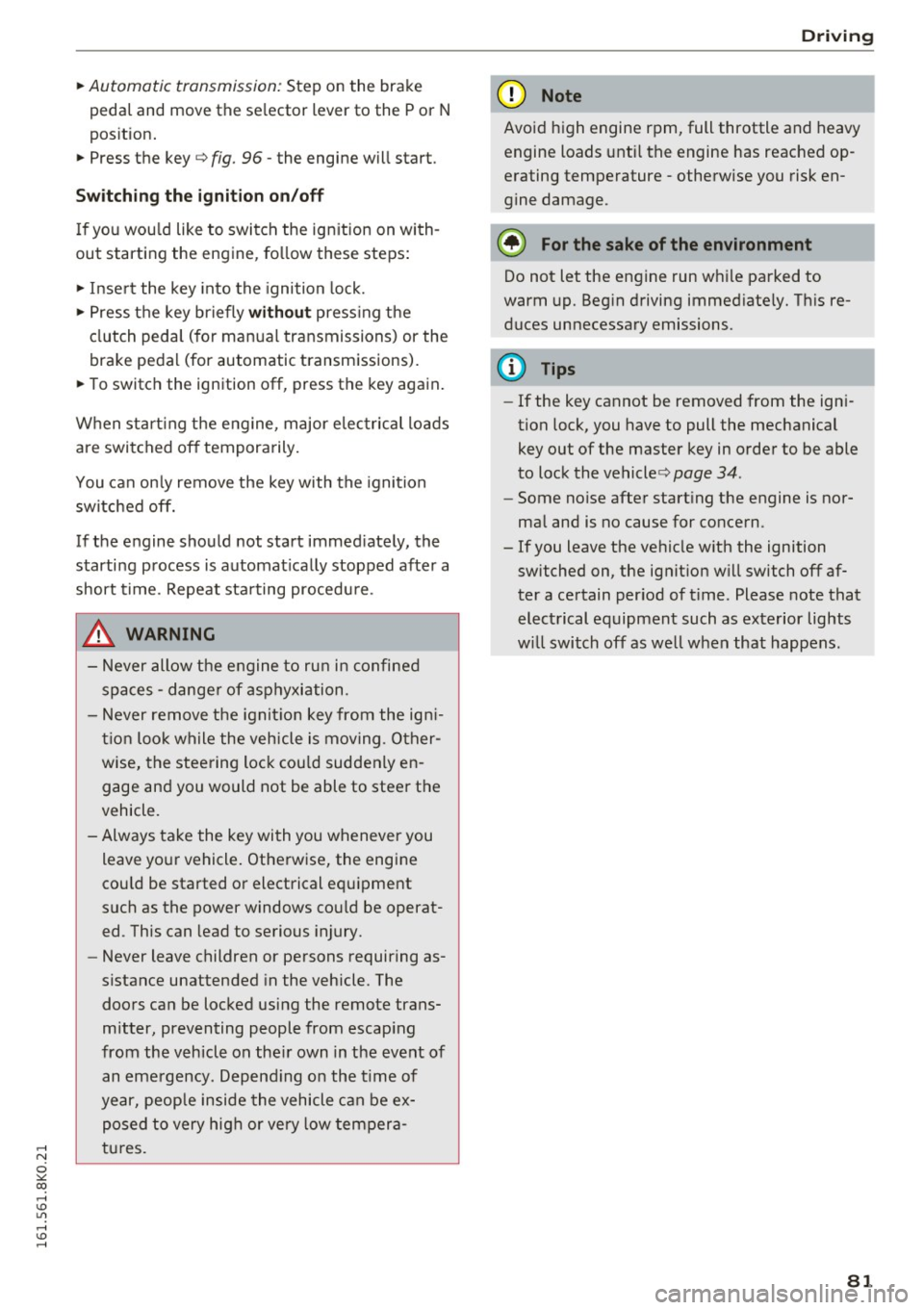
..... N
0 ::..:: co .....
peda l and move the se lector lever to the P or N
pos ition .
~ Press the key c::> fig. 96 - the engine will start.
Switchi ng the ignition on /off
If you wou ld like to switch the ig nition on with
out starting the engine, fo llow these steps :
~ Insert the key into the ignition lock.
~ Press t he key briefly withou t pressing the
clutch peda l (for manual transmissions) or the
brake pedal (for automatic transmissions).
~ To switch the ignition off, press the key again .
When start ing t he engine, major elec trical loads
are switched off tempora rily.
You can on ly remove the key with the ignition
switched off.
If the engine should not start immed iately, the
starting process is automat ically stopped after a
short time. Repeat sta rting procedu re .
_& WARNING
- Never allow the e ngine to ru n in confined
spaces - danger of asp hyxiation.
- Never remove the ign it io n key from the ig ni
t ion look while the vehicle is moving. O ther
wise, the stee ring lock cou ld suddenly en
gage and you would not be able to steer t he
vehicle.
- Always take the key wi th you whenever you
leave your vehicle . Otherwise, the engine
cou ld be started or electrical equipment
such as the power windows cou ld be operat
ed. This can lead to serious injury.
- Never leave children or persons requiring as
sistance unattended in the vehicle. The
doors can be locked using the remote trans
mitter, preventing people from escap ing
from the vehicle on the ir own in the event of
an eme rgency. Depend ing on the t ime of
year, peop le inside the vehicle can be ex
posed to very hig h or very low tempera
tures .
-
D riv ing
(D Note
Avoid high engine rpm, full throttle and heavy
engine loads unti l the engine has reached op
erating temperature - otherwise you risk en
gine damage.
@ For the sake of the environment
Do not let the engine run w hile parked to
warm up. Beg in driving immed iate ly. Th is re
duces unnecessary emissions.
(D Tips
- If the key cannot be removed from the ign i
tion lock, you have to pull the mechanical
key out of the master key in order to be able
to lock the vehicle c::>
page 34.
-Some noise after starting the engine is nor
mal and is no cause for concern.
- If you leave the vehicle w ith the ignition
switched on, the ignit ion w ill switch off af
ter a certain per iod of t ime. Please note that
electrical equipment such as exterior lights
w ill switch off as we ll w hen that happens.
8 1
Page 84 of 278
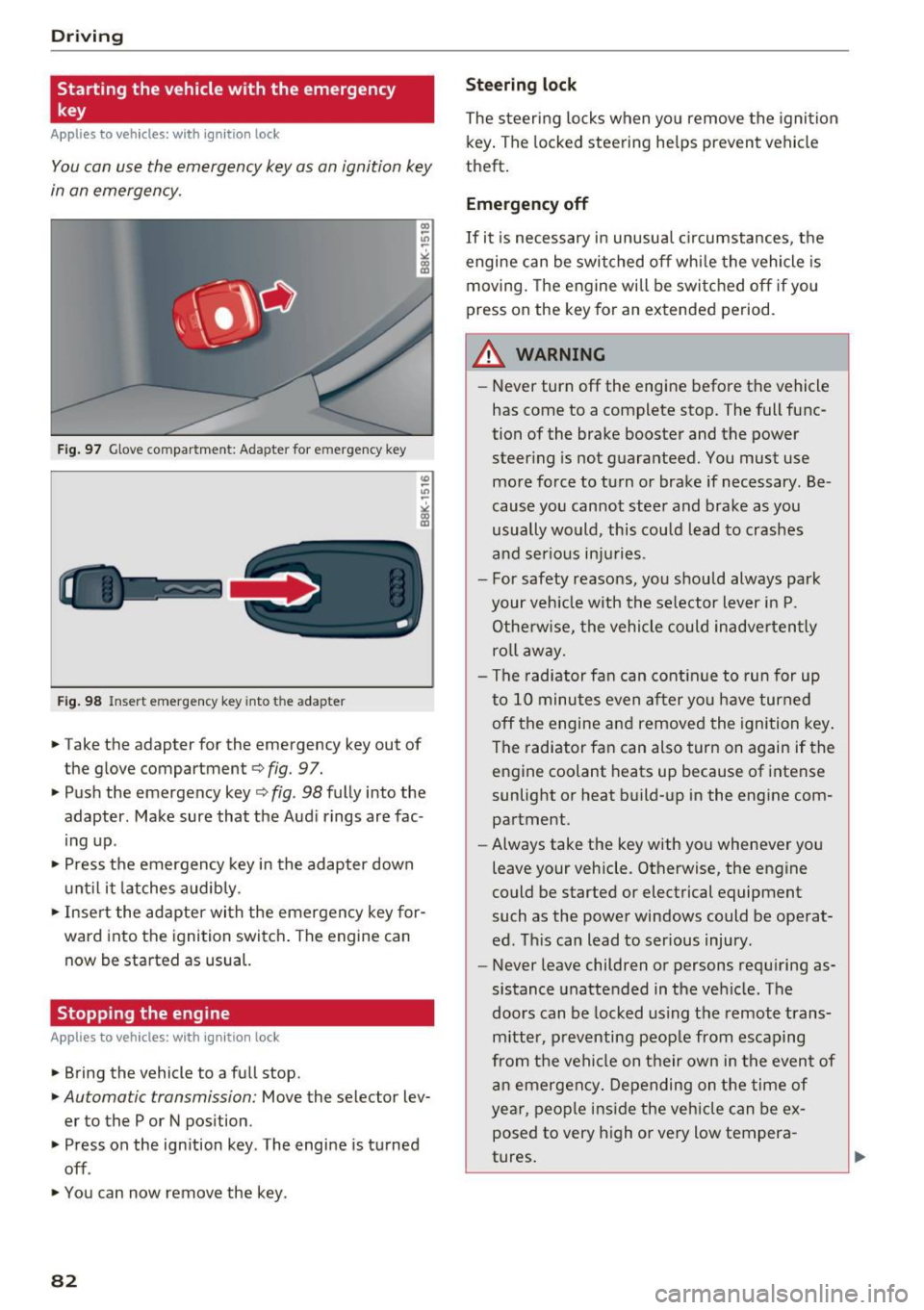
Driving
Starting the vehicle with the emergency
key
Applies to veh icles: w ith ig ni tio n lock
You can use the emergency key as an ignition key
in an emergency.
Fig. 97 Glove compartment: Adapter for e mergen cy key
Fig. 98 Insert emergency key into t he adapte r
.,. Take the adapter for the emergency key out of
the glove compartment ¢
fig. 97.
.,. Push the emergency key¢
fig. 98 fully into the
adapter. Make sure that the Audi rings are fac
ing up.
.,. Press the emergency key in the adapter down
until it latches audibly.
.,. Insert the adapter with the emergency key for
ward into the ignition switch. The engine can
now be started as usual.
Stopping the engine
App lies to veh icles: w ith ig ni tio n lock
.,. Bring the vehicle to a full stop.
.,. Automa tic transmission: Move the selector lev
er to the P or N position .
.,. Press on the ignition key . The engine is turned
off .
.,. You can now remove the key .
82
Steering lock
The steering locks when you remove the ignition
key. The locked steering helps prevent vehicle
theft.
Emergency off
If it is necessary in unusual circumstances, the
engine can be switched off while the vehicle is
moving. The engine will be switched off if you
press on the key for an extended period .
A WARNING
-Never turn off the engine before the vehicle
has come to a complete stop. The full func
tion of the brake booster and the power
steering is not guaranteed. You must use
more force to turn or brake if necessary . Be
cause you cannot steer and brake as you
usually would, this could lead to crashes
and serious injuries .
- For safety reasons, you should always park
your vehicle with the selector lever in P .
Otherwise, the vehicle could inadvertently
roll away.
- The radiator fan can continue to run for up
to 10 minutes even after you have turned
off the engine and removed the ignition key .
The radiator fan can also turn on again if the
engine coolant heats up because of intense
sunlight or heat build-up in the engine com
partment .
- Always take the key with you whenever you
leave your vehicle . Otherwise, the engine
could be started or electrical equipment
such as the power windows could be operat
ed. This can lead to serious injury .
- Never leave children or persons requiring as
sistance unattended in the vehicle. The
doors can be locked using the remote trans
mitter, preventing people from escaping
from the vehicle on their own in the event of
an emergency. Depending on the time of
year, people inside the vehicle can be ex
posed to very high or very low tempera
tures.
Page 86 of 278
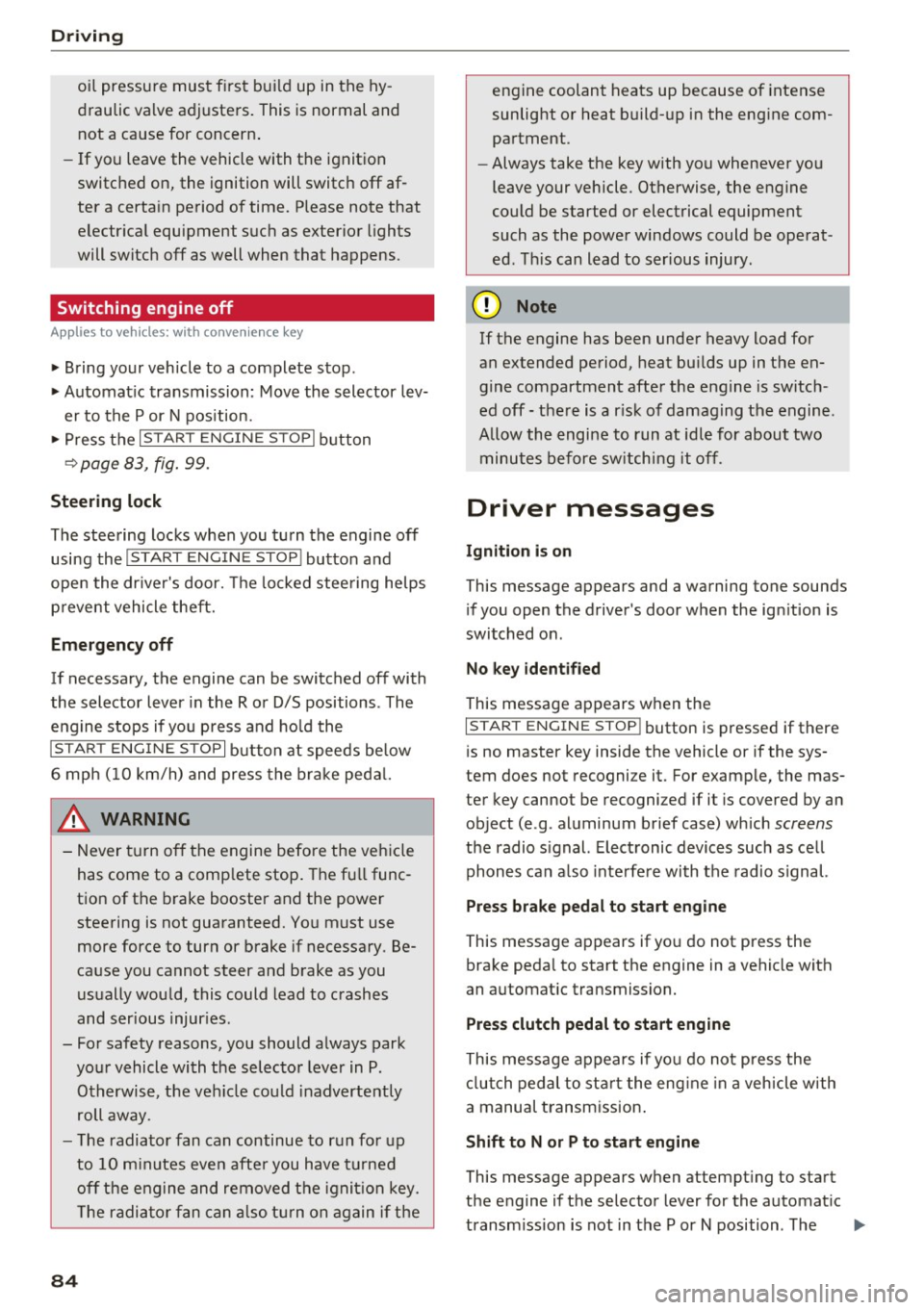
Driving
oil pressure must first build up in the hy
draulic valve adjusters. This is normal and not a cause for concern.
- If you leave the vehicle with the ignition
switched on, the ignition will switch off af
ter a certain period of time. Please note that
electrical equipment such as exterior lights
will switch off as well when that happens .
Switching engine off
Applies to veh icles: w ith conven ience key
" Bring your vehicle to a complete stop .
" Automatic transmission: Move the selector lev
er to the P or N position.
"Press the
I STA RT ENG INE S TOPI button
~ page 83, fig. 99.
Steering lock
The steering locks when you turn the engine off
using the
I START E NGINE STOP ! button and
open the driver's door. The locked steering helps
prevent vehicle theft.
Emergency off
If necessary, the engine can be switched off with
the selector lever in the R or D/S positions . The
engine stops if you press and hold the
I STAR T ENGIN E STOPI button at speeds below
6 mph (10 km/h) and press the brake pedal.
A WARNING
-Never turn off the engine before the vehicle
has come to a complete stop. The full func
tion of the brake booster and the power
steering is not guaranteed. You must use
more force to turn or brake if necessary. Be
cause you cannot steer and brake as you
usually would, this could lead to crashes
and serious injuries.
- For safety reasons, you should always park
your vehicle with the selector lever in P.
Otherwise, the vehicle could inadvertently
roll away .
- The radiator fan can continue to run for up
to 10 minutes even after you have turned
off the engine and removed the ignition key.
The radiator fan can also turn on again if the
84
engine coolant heats up because of intense
sunlight or heat build-up in the engine com
partment.
- Always take the key with you whenever you
leave your vehicle . Otherwise, the engine
could be started or electrical equipment
such as the power windows could be operat
ed. This can lead to serious injury.
(D Note
If the engine has been under heavy load for
an extended period, heat builds up in the en
gine compartment after the engine is switch
ed off - there is a risk of damaging the engine .
Allow the engine to run at idle for about two
minutes before switching it off.
Driver messages
Ignition is on
This message appears and a warning tone sounds
if you open the driver's door when the ignition is
switched on .
No key identified
This message appears when the
I STAR T ENGINE ST OP ! button is pressed if there
is no master key inside the vehicle or if the sys
tem does not recogni ze it. For example, the mas
ter key cannot be recognized if it is covered by an
object (e .g . aluminum brief case) which
screens
the radio signal. Electronic devices such as cell
phones can also interfere with the radio signal.
Press brake pedal to start engine
This message appears if you do not press the
brake pedal to start the engine in a vehicle with
an automatic transmission.
Press clutch pedal to start engine
This message appears if you do not press the
clutch pedal to start the engine in a vehicle with
a manual transmission.
Shift to N or P to start engine
This message appears when attempting to start
the engine if the selector lever for the automatic
transmission is not in the P or N position . The .,_